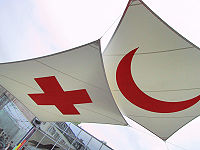
The organized International Red Cross and Red Crescent Movement is a humanitarian movement with approximately 16 million volunteers, members, and staff worldwide. It was founded to protect human life and health, to ensure respect for all human beings, and to prevent and alleviate human suffering. Within it there are three distinct organisations that are legally independent from each other, but are united within the movement through common basic principles, objectives, symbols, statutes, and governing organisations.
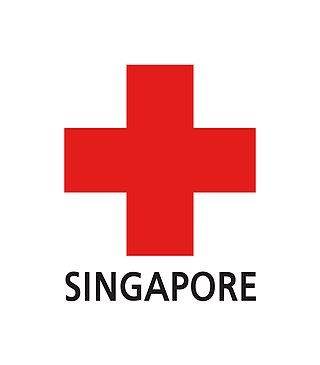
The Singapore Red Cross (SRC), formally the Singapore Red Cross Society, is a humanitarian aid and community services charity in Singapore. The SRC is a national member of the Federation of Red Cross and Red Crescent Societies (IFRC) and International Committee of the Red Cross (ICRC) and forms a part of the International Red Cross Movement.

The Turkish Red Crescent is the Turkish affiliate of the International Red Crescent and the first worldwide adopter of the crescent symbol for humanitarian aid.

Medair is an international non-governmental organisation (INGO) whose purpose is to relieve human suffering in some of the world's most remote and devastated places. Medair aims to assist people affected by natural disasters and conflict to recover with dignity through the delivery of quality humanitarian aid.
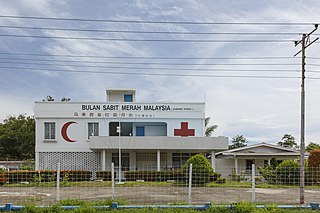
The Malaysian Red Crescent (MRC) is a voluntary humanitarian organization that seeks to promote humanitarian values, as well as provide service and public education in disaster management, as well as healthcare in the community. It is part of the International Red Cross and Red Crescent Movement.

The International Federation of Red Cross and Red Crescent Societies (IFRC) is a worldwide humanitarian aid organization that reaches 160 million people each year through its 191 member National Societies. It acts before, during and after disasters and health emergencies to meet the needs and improve the lives of vulnerable people. It does so independently and with impartiality as to nationality, race, gender, religious beliefs, class and political opinions.

The Qatar Red Crescent Society, the Qatari branch of the Red Crescent Society, was established in 1978. In 1981, it gained international recognition from the International Committee of the Red Cross in Geneva and joined the International Federation of Red Cross and Red Crescent Societies (IFRC). It is also a member of the Secretariat of Arab Red Crescent Societies in Jeddah. It became the first philanthropic organization in Qatar to establish a women's branch in 1982.
The Trinidad and Tobago Red Cross Society (TTRCS) was founded on 12 July 1939 as a Branch of the British Red Cross Society. It has its headquarters in Port of Spain, with branches in the North and South of the island of Trinidad and one branch on the island of Tobago. Following the attainment of independence in 1962, the TTRCS became an Independent Society by Act No. 15 of 1963. On 8 August 1963, the TTRCS became part of the International Committee of the Red Cross and the International Federation of Red Cross and Red Crescent Societies. The Constitution of the Trinidad and Tobago Red Cross Society is based on the Geneva Conventions of 1949 and their additional Protocols of 1977 and the Fundamental Principles of the Red Cross Red Crescent Movement which are:
The Sudanese Red Crescent (SRC) is the biggest and most decentralized and widespread humanitarian organization operating in Sudan. The society developed out of the Sudan branch of the British Red Cross Society and was established in 1956. Upon Sudan's independence in March 1956 received official recognition as an independent National Society following the Sudanese Council of Ministers decree No. 869. The National Society covers nearly the entire country with 15 State branches and several sub-branches/units in the provinces/localities and administrative units, with a nationwide community-based network of 35,000 active volunteers and another 300,000 who can be deployed as need arises. It has well-established working relations with public authorities at federal, state and local levels, and good partnership and collaboration with Movement partners and UN specialized agencies and national and international NGOs working in Sudan.
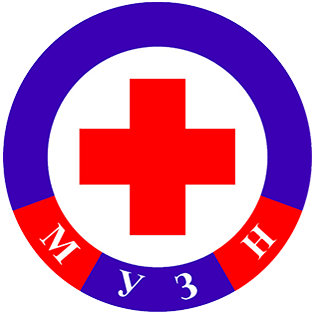
The Mongolian Red Cross Society is the largest humanitarian organization in Mongolia. It was established in 1939 as part of the International Red Cross and Red Crescent Movement and is an auxiliary to the Mongolian Government.
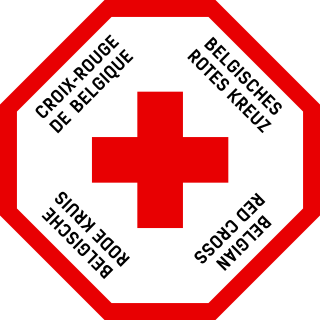
The Belgian Red Cross is a humanitarian organization that aids in providing emergency and disaster related services and relief as well as providing education for disaster awareness within the population of Belgium. It is a member of the International Federation of Red Cross and Red Crescent Societies.

New Zealand Red Cross or Rīpeka Whero Aotearoa is a humanitarian organisation, which has more than 9,000 members and volunteers. In New Zealand, Red Cross delivers core community services, such as Meals on Wheels, refugee re-settlement services, first aid courses, and emergency management operations. Internationally, New Zealand Red Cross sends international delegates overseas to assist in areas where humanitarian assistance is needed, this includes disaster preparedness and response. In 2013, 17 delegates were sent to the Philippines in the aftermath of Typhoon Haiyan and in 2014, 18 New Zealand delegates responded to the Ebola epidemic in West Africa.

The Albanian Red Cross, or ARC, is the national society member of the International Federation of Red Cross and Red Crescent Societies for Albania. The oldest humanitarian organization in Albania, it was founded on October 4, 1921, and was officially recognized by the Red Cross and Red Crescent Movement in 1923. Its headquarters are located in the Albanian capital of Tirana, and its 39 branches provide humanitarian assistance across the country in accordance with the Fundamental Principles.

The Indian Red Cross Society (IRCS) is a voluntary humanitarian organization to protect human life and health based in India. It is part of the International Red Cross and Red Crescent Movement and shares the Fundamental Principles of the International Red Cross and Red Crescent Movement. The society's mission is to provide relief in times of disasters/emergencies and promote health and care of vulnerable people and communities. It has a network of over 700 branches throughout India. The Society uses the Red Cross as an emblem in common with other international Red Cross societies. Volunteering has been at the very heart of the Indian Red Cross Society since its inception in 1920, with the Society having Youth and Junior volunteering programmes. The Society is closely associated with St John Ambulance India.
The Maldivian Red Crescent (MRC) is an independent, volunteer, non-profit, humanitarian organization established in the Maldives by virtue of the Maldivian Red Crescent Act Law No: 7/2009
South Sudanese refugees are persons originating from the African country of South Sudan, but seeking refuge outside the borders of their native country. The world's youngest independent country has a recent and troubled history of prolonged conflicts and ecosystem mismanagement such as overlogging, which has led to desertification. These forces have resulted not only in violence and famine, but also the forced migration of large numbers of the population, both inside and outside the country's borders. South Sudan was cited as the largest refugee crisis in 2016, being the world's third largest, followed by Syria and Afghanistan. As of 2022, the UNHCR estimated that there were 2.4 million refugees under its mandate originating from South Sudan, making the country the fifth largest source of refugees.
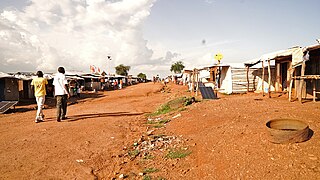
Bidibidi Refugee Settlement is a refugee camp in the Yumbe District of northwestern Uganda. Home to over 270,000 South Sudanese refugees fleeing the ongoing civil war in mid 2016, it was among the largest refugee settlements in the world at the time, and may have been the largest. As of 2018, that distinction was claimed by Kutupalong refugee camp for displaced Rohingya in Bangladesh.
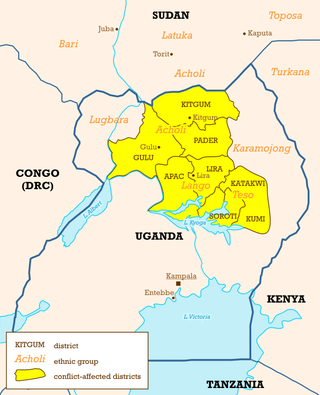
Uganda is one of the largest refugee-hosting nations in the world, with 1,529,904 refugees. The vast influx of refugees is due to several factors in Uganda's neighboring countries, especially war and violence in South Sudan and the Democratic Republic of the Congo, and associated economic crisis and political instability in the region. Uganda has relatively 'friendly' policies that provide rights to the refugees, such as rights to education, work, private property, healthcare and other basic social services.
Stephen Omollo, is a Kenyan humanitarian and leader.
